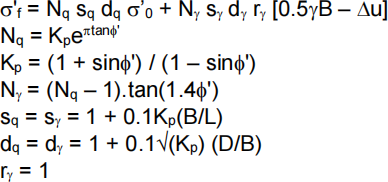CENV3020 GEOTECHNICAL ENGINEERING ASSESSMENT PAPER 2021/22
Hello, dear friend, you can consult us at any time if you have any questions, add WeChat: daixieit
ASSESSMENT PAPER 2021/22
TITLE – CENV3020 GEOTECHNICAL ENGINEERING
Question 1
Figure Q1 shows a concrete thrust block, constructed in the base of an excavation as a foundation for a set of raking props supporting a large retaining structure.
(a). By considering the limiting equilibrium of a series of potential passive sliding wedges extending from the bottom corner of the thrust block, determine the maximum horizontal force that the soil is able to provide to maintain the lateral stability of the thrust block. The thrust block, soil, and groundwater geometry, and soil and interface properties are given in Figure Q1. You may solve the problem either graphically by means of force vector diagrams, or algebraically by resolving forces. You should apply a factor of safety of 1.25 to tanΦ’. State clearly any assumptions that you need to make. [24 marks]
(b). Explain qualitatively how the calculation for the passive resistance of the soil behind the stress block could be approached using a lower bound analysis. [5 marks]
(c). Draw a free body diagram of the thrust block, and label onto it the magnitude and line of action of forces where these are known. Assume that the raking props meet the thrust block at the height and angle shown in Figure Q1, that they are spaced at 5 m intervals along the thrust block and each carry a load of 350 kN. State clearly any assumptions that you need to make. [7 marks]
(d). Use horizontal, vertical and moment equilibrium of the thrust block to determine the magnitude and line of action of the resultant of shear and normal forces acting on the base of the block. Where needed, you should apply a factor of safety of 1.25 to tanΦ’. State clearly any assumptions that you need to make. Comment on both the overall lateral and moment stability of the stress block. [8 marks]

Figure Q1. Section through the concrete thrust block, showing the geometry of the surrounding soil and piezometric surfaces, and concrete, soil and interface properties.
(e). Suggest three further calculations that would be required to complete the thrust block design. [3 marks]
[Total Q1 = 47 marks]
Question 2
(a). Explain what happens to the total stress, effective stress, and pore water pressure in an element of clay soil as (i) a shallow foundation is loaded rapidly above it, and then (ii) as groundwater flow takes place towards equilibrium conditions (with the load still applied to the foundation). What is the effect of these changes on the stability of the foundation? [4 marks]
A contractor needs to construct a warehouse building on soft ground, comprising sediments of clay and silty clay. The ground profile is shown in Figure Q2.
(b). Explain why the ground conditions may lean towards the use of pile, rather than pad foundations? [3 marks]
(c). The contractor is considering whether to use bored or driven piles as the foundations to support the main columns of the warehouse building. Suggest the main advantages and disadvantages of using bored piles versus driven piles. [6 marks]

Figure Q2. Ground profile for warehouse building.
(d). The contractor has decided to construct bored piles of 350 mm diameter. If the piles are used in a group of four to support each building column load of 1000 kN, determine the length of the piles required to meet both short-term undrained, and long-term drained conditions. The soil profile and properties are given in Figure Q2, along with the groundwater conditions. You should apply a factor of safety of 1.4 to tu, and 1.25 to tanΦ’. In the undrained calculation, assume that the adhesion at the pile-soil interface, tw, is equal to 0.5 tu. In the drained calculation, take the pile-soil interface strength δ = Φ’, and in calculating the base resistance of the pile, ignore the Ng term in the bearing equation. State any other assumptions that you need to make. [32 marks]
(e). Suggest three further calculations that would be required to complete the foundation design. [3 marks]
(f). Describe how you could estimate the displacement/settlement of the foundation under working load. [5 marks]
[Total Q2 = 53 marks]
Foundation bearing equations:
Undrained bearing capacity equations:

Drained bearing capacity equations:

Where:
B = Width of foundation
D = Depth of foundation
L = Length of foundation
2024-01-19